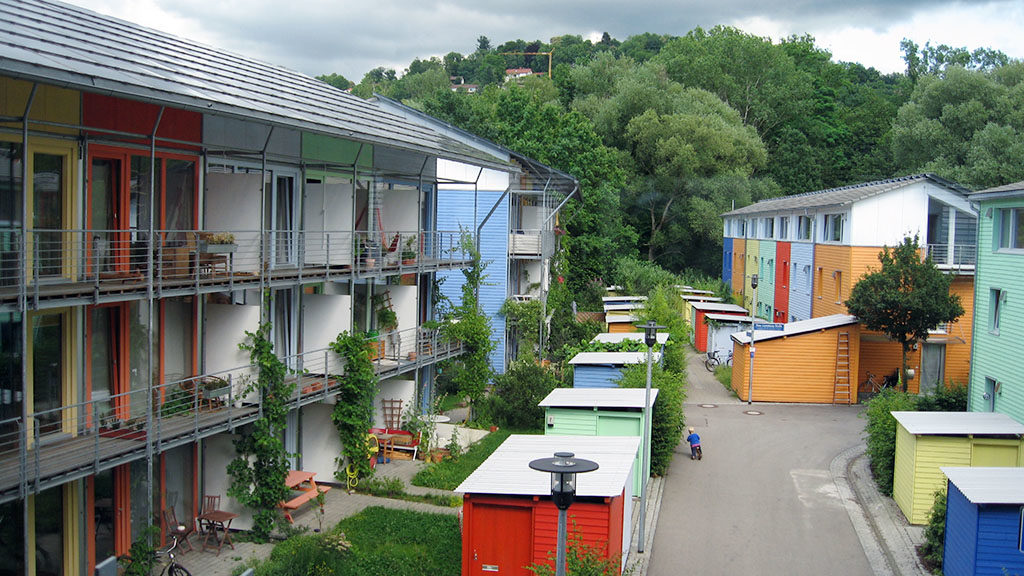
(Re)Building cities from the neighbourhood up
A new book argues that if our cities are to cope with the challenge of climate change, they will need to be reinvented from first principles, with ecological urbanism in mind.
The Sense of a Neighbourhood
Four people are chatting in front of Quartiersladen, the local shop. It is a rainy day in the neighbourhood of Vauban in Freiburg, Germany, yet they take their time. One of them is holding a bicycle, another carries two bags of groceries. A child pulls at her father’s arm to make him move along. ‘This is precisely what we had imagined when we developed the neighbourhood. If we would keep cars at a distance, integrate shops in the housing blocks, and create a broad pavement for pedestrians while allowing bicycles, we might create the circumstances for people to meet, for conviviality’, says Philipp, a long-time resident.
Vauban is celebrated internationally as a ‘green’ neighbourhood, scoring high on nearly all sustainability criteria. It is known for its ‘passive houses’: houses that produce more energy than the households themselves require; for its mobility strategy, privileging bicycles and public transport; and for its soft relationship with the natural environment surrounding it. Yet, standing at the corner of the Kurt-Tucholsky-Straße and the Vauban Allee in Freiburg, and seeing how people socialize, the social qualities of this neighbourhood are arguably at least as remarkable.
Above all, Vauban leaves you with a sense of possibility; the feeling that there are alternatives to how we usually build cities; the awareness that making our cities climate-proof and making them more sociable and pleasant places to live in at the same time, is possible. Shops are locally-owned. Philipp points at a large wood-fired pizza oven that was built in one of the pocket parks in between the housing blocks. It was expensive to construct and the municipality was reluctant to put it in, wary of vandalism and the cost of maintenance. ‘It is there for anyone to use. You just pick up the key from that shop over there, unlock it and it is ready for use. We have never had any trouble. On the contrary, people are proud of it and cherish it.’
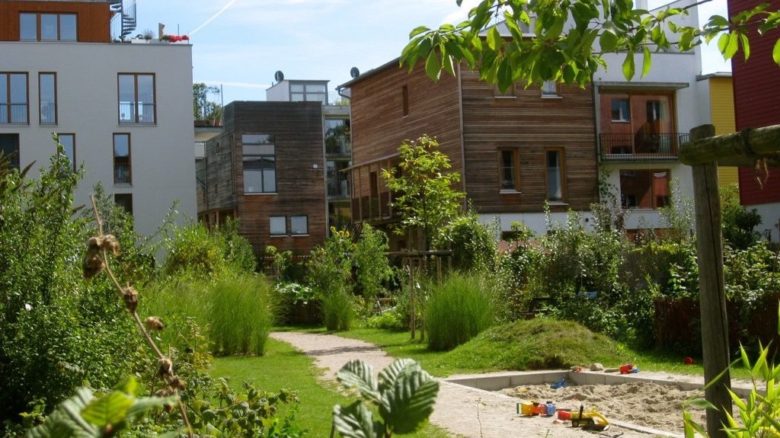
Neighbourhood courtyards in Vauban Photo credit: Jute Marketing
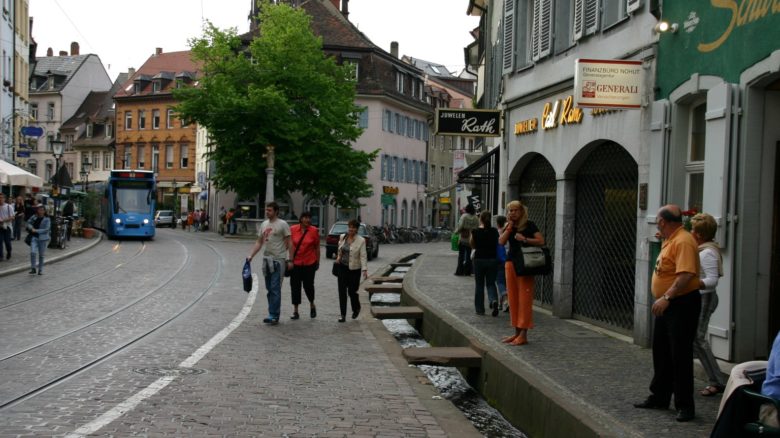
Neighbourhood courtyards in Vauban Photo credit: Alain Rouiller
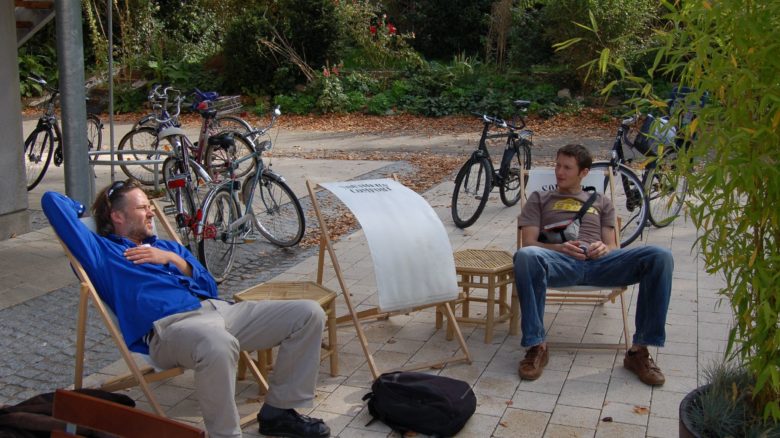
Opportunities to truely relax are built into Vauban's streetscapes Photo credit: Andy Wright
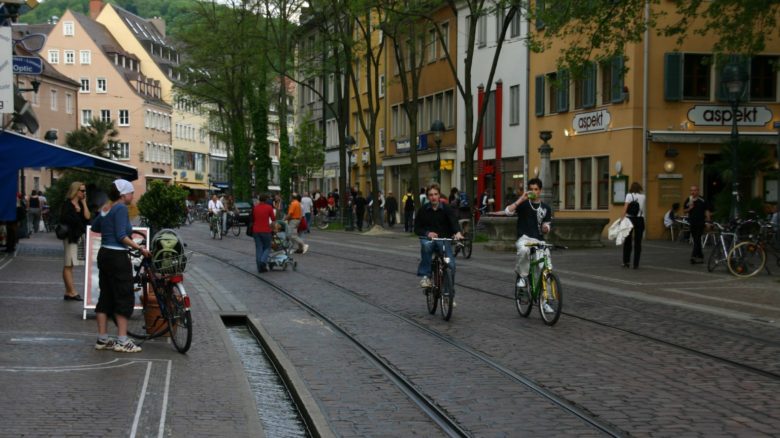
Mixed transport and pedestrian space in Vauban's city centre Photo credit: Alain Rouiller
Our book is about neighbourhoods. It is a plea for revisiting what was once a cornerstone of urbanism and now deserves to take centre stage again. We have assigned our cities the grandiose task of becoming ‘climate neutral’ in 2025, 2030, or 2040. CO2 reduction is crucial, but how will people live in those cities? Can we make cities better places to live in while we are busy reducing our carbon footprint? Can we also connect the leading ‘CO2 agenda’ to other issues of environment and health, such as air pollution, contaminated soil, and sustainable resource use in general? Can we make the connection between urbanism and sustainable living, culminating in sustainable ways of life? We think there are many ways to combine sustainability and sociability. For this, neighbourhoods are the crucial point of intervention. We should rebuild our cities from the neighbourhood up and dare to make them better places.
However, if we want to help rebuild our cities with such social qualities in mind, we need to understand what determines that quality, and when and how it actually got built. Throughout our book, we seek to stretch the imagination of what is possible, create a new appetite to make better cities and tap into a new level of ambition. We coin two new concepts. First of all, the notion of neighbourhood ecologies to refer to the qualities in which sustainability can be combined with enhanced sociability. Moreover, we seek to reveal why certain neighbourhoods became so successful. We do this by analyzing the particular neighbourhood arrangements that help understand why neighbourhoods develop certain characteristics. Applying this to the case of Vauban, you cannot understand the social and physical qualities that they have achieved without appreciating the legal rules that gave the developments rights to Baugruppen, small cooperatives of people who wanted to live there. They built the apartment blocks that comprise the neighbourhood. The Baugruppen pooled money and plans and were able to leverage bank loans to actually construct the linear blocks of about fifty units typical for the district. It reminds us that behind remarkable ecological and social qualities there always is a unique neighbourhood arrangement, made up of ideas, actors, rules, and resources. And perhaps it is this particular neighbourhood arrangement that Vauban should be at least as famous for.
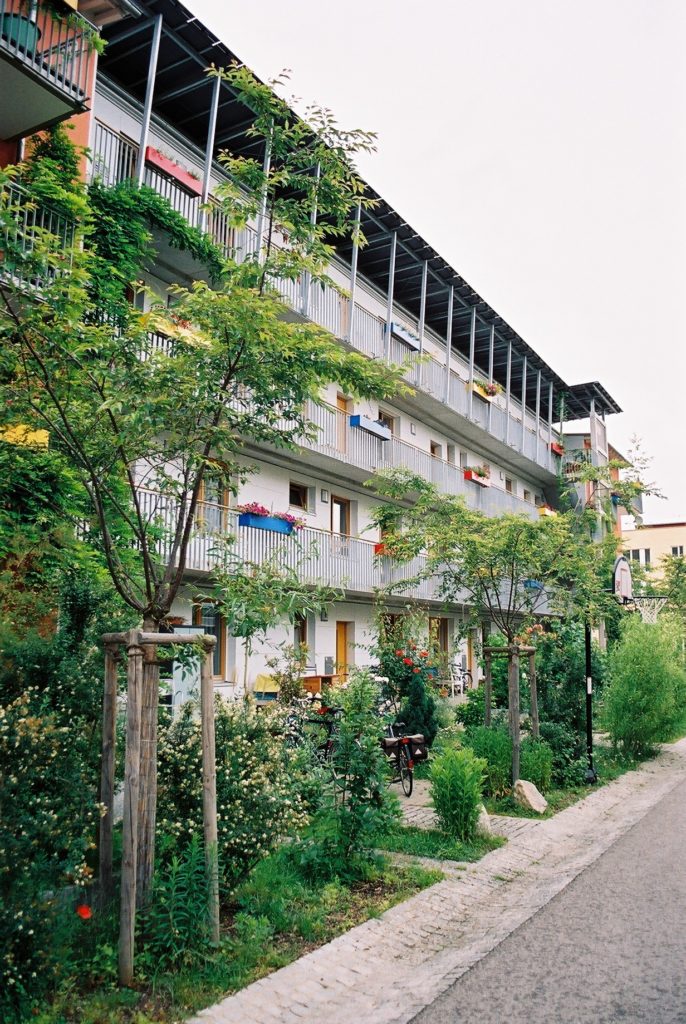
Photo credit: Adeupa Brest
Cities in Times of the Climate Crisis
We argue that neighbourhoods are the best entry point for making better cities. But we argue this case knowing that the main challenge for our cities in the coming decades is dealing with the climate crisis. We will have to make sure that our cities, our buildings, our transportation, indeed, our very organization of urban life, is reorganized in such a way as to first stop the rise of CO2 emissions and then to bring emissions down to about one tenth of the current levels. Moreover, with erratic weather patterns, from heat waves to torrential rains, we will have to make sure we can cope with the disruptions caused by human-caused climate change. We will need cooler and more resilient cities.
If we continue to build cities as we did in the twentieth century, we will simply blow the fuses of the planet, as Mark Swilling once put it. We cannot afford to build cities at very low densities using ever more concrete, steel, and tarmac. We urgently need to change our way of urban development. The established UN DESA statistics suggest that 66 percent of the world’s population will be living in cities in 2050. To house all those new residents a stunning 40 percent of the urban fabric of 2050 still has to be built, predominantly in Asia and Africa. In a recent study, The Weight of Cities, a group of academics working for the UN International Resource Panel (IRP) calculated the resource requirements for this future urbanization. The dominant trend is one of de-densification, of building cities outwards by 2 percent per year, resulting in an increased reliance on cars and motorways, locking cities into high consumption of fossil fuels and other natural resources.
We now have to find a way to alter this trend. This will have to start with changing our way of thinking about the urban environment. Using the neighbourhood as our lens, we see a new sort of cityscape emerging, with much more emphasis on cool, green space, on water retention, with more human interaction, with public or shared forms of transport and with all sorts of amenities close-by so as to avoid having to travel longer distances on a daily basis. Well-functioning, ecological neighbourhoods taking the place of sprawling suburbs and dysfunctional high-rise. Of course, such neighbourhoods do not stand alone, but are functionally, socially, and institutionally linked to each other and are nested in a wider urban context.
To arrive at this reimagination, we suggest liaising with the power of the current wave of actions to cut emissions and ‘climate proof’ our cities. Housing insulation is high on the agenda, using district heating and electricity to heat our homes and replace natural gas infrastructures is on the table, and replacing coal-fired power stations with renewable energy sources is well underway. This is a very powerful force, involving hundreds of billions of euros and dollars. Yet we see a real risk that, if left to its own devices, climate policy may become a technology-focused and even technocratic quest that creates little social support on the way. Indeed, and probably much more likely, that it will meet with fierce social opposition resulting in slow implementation. Instead, we argue to approach planetary challenges from the neighbourhood up, directly linking the interventions to local concerns.
The urgency to rethink how we build and transform our cities is broader than climate change. We are now at the beginning of what will be a sustained period of ‘climate proofing’ our cities. Partly, this will be about dealing with the emerging consequences of the climate crisis, but surely it will also be about getting CO2 equivalents out of the energy mix, out of our diets, out of our way of moving about. This is a phase of fierce debates about the relative merits of district heating systems, heat pumps, private versus shared mobility, reprioritizing the roads and streets for either CO2-intense or CO2-free or CO2-low forms of transport, individual versus collective solutions, certification schemes, or the (relative) potential of geothermal solutions. However, while recognizing the central importance of the climate crisis in urban strategies, it would be a mistake to work towards CO2 reduction as a single purpose pursuit. Instead, we suggest it makes more sense and will be more effective to try and merge the effort to curb CO2 and make cities climate-proof (that is, able to deal with heat, drought and torrential rains) with the effort to make them healthier and socially more just. Indeed, we argue that we need to create places that are not only resilient but all-around more pleasant places to live in, places that bring out the best in people. Then the level of the neighbourhood suddenly is crucial in realizing this planetary task.
The Plea for an Ecological Urbanism
We call for a new agenda of an ecological urbanism. ‘Ecology’ has been used frequently in the urbanist literature, from the Chicago School to a range of more recent adaptations. But we want to take a next step, which we will clarify below. Ecological urbanism signals, first of all, the need to make nature an inseparable part of thinking about cities. At the moment, urbanization is basically ‘building on top’ of the natural environment. This echoes the modernist ideal of tabula rasa planning, in which the natural context was often erased to make way for the stylized geometry of modernist urban forms. But in a more practical sense, this tradition is still with us. Concrete is often used to provide an impenetrable ‘floor’ in the city, the most dramatic example being airports where many square kilometres of nature are covered in concrete. Elsewhere urbanization takes place in floodplains, hindering the flow of rivers. This approach proves to be very vulnerable in times of torrential rain, leading to flooding and disruption. The most immediate response has been the Chinese call for ‘sponge cities’, emphasizing the need to absorb water in the urban environment. A more profound break with modernist urbanism is the idea of nature-based solutions, in which the power and intelligence of the natural environment is taken as a starting point for finding solutions. An ecological urbanism suggests that we need to take nature into account when thinking about the future of our cities.
The second dimension of an ecological urbanism refers back to its sociological usage. Way back, in the 1920s and 1930s, urbanists such as Louis Wirth, Robert E. Park, and Ernest W. Burgess introduced the ecological metaphor, emphasizing the fact that city life had the characteristics of a complex ecosystem, in which people attracted each other, or pushed others out. That approach to urban dynamics is something worth reconsidering when thinking about the neighbourhoods for the future. Well-functioning neighbourhoods have their own social ecology as well. Indeed, one of the reasons why many of the modernist high-rise environments proved to be inhabitable in the long run, has to do with that lack of such an urban dynamics, in which functions that live off each other, that complement each other, can also find a spatial expression, creating the nodes that are typical of good neighbourhoods.
The term ‘ecological urbanism’ has been used before, most notably in a large volume edited by Mohsen Mostafavi and Gareth Doherty. We want to take a next step, providing the conceptual tools to help understand the challenges in creating neighbourhoods for the future. This requires a repositioning of the principles of urbanism. Only then can we avoid merely paying lip service to the vast ecological challenges we face, like for example in architect Stefano Boeri’s ‘vertical forests’. This new type of building is a commercial success but in essence just adds a visible layer of green to an urban fabric that is basically unaltered. This amounts to ‘greenwashing’ the modernist tradition, varnishing buildings and locations to improve the marketability of real estate.
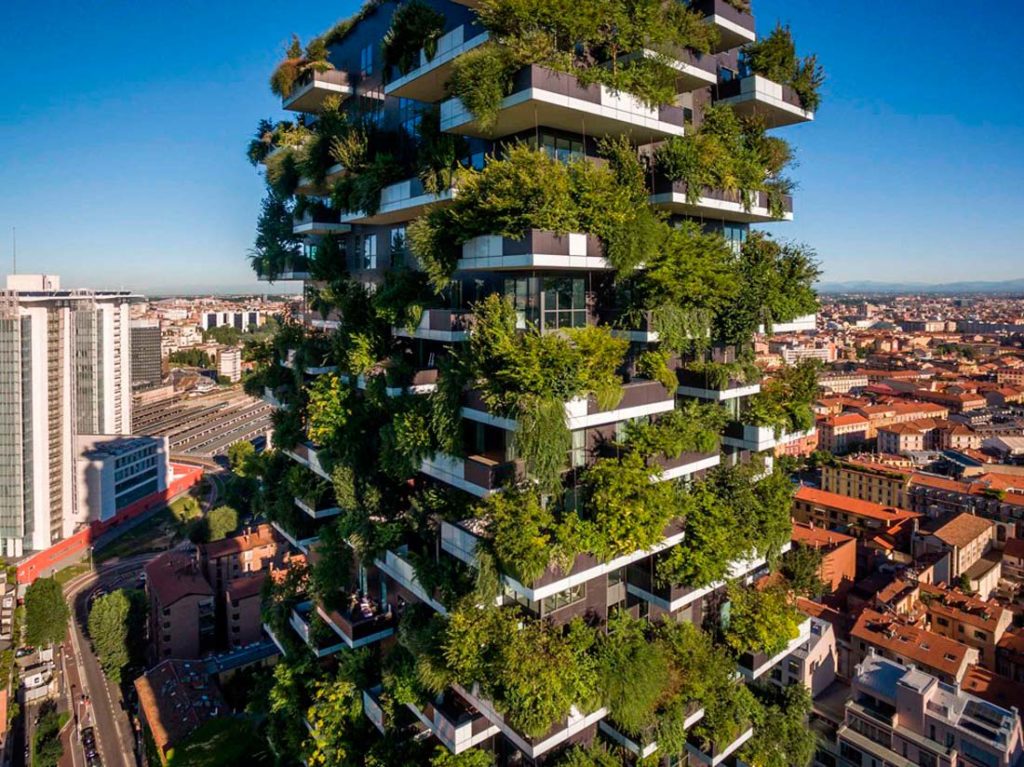
Here, we use the term ecological urbanism emphasizing the new agenda, combining seeing nature and the care for natural resources as an inseparable part of urbanization (nature-based solutions) on the one hand, and conceptualizing neighbourhoods (and beyond that cities), in a naturalistic way, as ‘ecosystems’ and ‘habitats’ on the other. An ecological urbanism thus gives new meaning to the goals we want to achieve. Ecology is used to emphasize the need to look at components of the urban in an integrated perspective, looking for ways in which they can create true ecosystems of elements that reinforce each other in producing good city life, appreciating the subtle ways in which neighbourhoods actually become nice places to live in. We argue for an approach in which the ‘ecological’ is bolted into, not onto urbanism.
An ecological urbanism starts from a recognition of how cities and nature are fundamentally intertwined. And this requires us to rethink some of the very fundamentals of making cities. First, we need to reconsider building materials. We are all but locked into a style of conceiving and building cities that leads to extremely high CO2 emissions. Reinforced concrete was (and still is) a favourite material for buildings and infrastructure alike, all because of its strength and, literally, malleability. Concrete was used to make pavements and surfaces for industry and airports. But the production of concrete, steel and cement is also a major source of CO2 emissions. This basically requires us to rethink the materials we use to build and improve our cities. This is by no means easy.
Moreover, we need to reconsider our commitment to a certain type of knowledge. Behind the materiality of today’s cities are ideas. Indeed, the preference for concrete and steel stems from an intellectual conviction. Modernist urbanism had a preference for geometry and tabula rasa, erasing existing landscapes to create the optimal spatial conditions for designed freedom. It was deeply felt at the time, and one should keep in mind that it also made sense: modern architecture and urban design were conceived as an answer to the unhealthy conditions of urban slum life at the time. And, arguably, this process of slum development was regarded as a natural process, an ‘urban cancer’, in the words of Lewis Mumford, against which the modernists tried to find a remedy. Hence, in that sense, for good reason. However, it suggested a superiority of analytical thinking over a type of knowledge that sees urban life as something that is growing, changing and constantly shifting. It suggested that a forceful break with the past was the logical next step, also in light of the need to speed up in times of serious housing shortages. The idea of the modernist visionary, with privileged access to knowledge, also suggested a limited openness to discussion, to debate and to amendments, indeed, to politics. The modernist fallacy was epistemological in the sense that it suggested a general law, a calculated optimum. The suggestion that we could and should aim for a type of urban solutions that were universal both in their claims to truth and in their applicability. It is this modernist conceptualization that gave us all these more or less identical high-rise developments, from the New York superblocks to the high-rise in Qom, Iran; from the banlieue of Paris to the satellite towns of Stockholm. But there was no eye for detail (the fact that Corbusier’s ‘modular man’ was based on the size of a European man did not hinder him from sticking to this standard when building in Chandigarh, India). Neither was there an ear for the struggle of people to try and make a living in a context that cost them energy instead of relieving them. Moreover, there was no anticipation that people may find modernist solutions less than optimal. Consequently, altering the modernist fabric proved to be very difficult, sometimes impossible. An ecological urbanism would fundamentally break with this idea of a theoretically and conceptually derived optimum and would instead aim to create knowledge that would allow stakeholders—including citizens—to find the best solutions, building on the insights of experts.
So, for us, an ecological urbanism is more than just a combination of the insights into what we need to do to cope with the climate crisis with the rich understanding of what makes for thriving cities. We think it calls for a new approach to planning, one that is much more appreciative of context, of how people make a living in cities, and definitely much more appreciative of how cities are fundamentally about movement and change, both of materials and natural flows as of people and their values. This idea of the city as a living organism, that should be understood against the background of its capacity to harness flows and to create a built environment that helps to express its collective values, is an important correction to all those that think that there is an optimum, an ideal city.
Ecological urbanism, then, is the theoretical approach to urbanization that combines the accumulated understanding of the physical side of the built environment with the understanding of social interaction in cities. It brings together the wisdom of its residents with the insights of experts and it, ultimately, seeks to be the new normative underpinning of a vibrant debate on what makes for thriving cities. It hopes to define a new leitmotiv for policymakers and city makers to further their quest to make better cities. As Richard Sennett has reminded us so often, good urban spaces are the product of an evolutionary understanding of the quality of place. If ecological urbanism is to be about the mastery of making better places that reduce our ecological footprint, then we should not start from the presumption that we ‘know’ what to do, but that we are finding out what can and should be done. It is an attitude, a ‘way of seeing’ that is appreciative of shifts and turns. It is more about wisdom than it is about fixed parameters and general laws, more about understanding complexities than a search for significant correlations. ‘A good-quality environment is one which can be repaired’, argues Sennett, and that should also apply to the new ‘climate-proof’ neighbourhoods and retrofits that are currently underway.
Maarten Hajer is a distinguished professor in Urban Futures and Director of the Urban Futures Studio at Utrecht University.
Peter Pelzer is an assistant professor in Spatial Planning and Urban Futures at the Department of Human Geography and Spatial Planning at Stretch University and affiliated with the Urban Futures Studio.
Martijn van den Hurk is an assistant professor in Geosciences, Human Geography and Spatial Planning at Utrecht University.
Chris ten Dam Copernicus Institute of Sustainable Development at Utrecht University.
Edwin Buitelaar is a professor of land and real estate development at Utrecht University and a senior researcher of urban development at the PBL Netherlands Environmental Assessment Agency.
The book Neighbourhoods for the future is available to purchase through Valiz Publishing.


